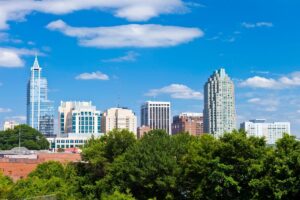Writer: Felipe Rivas
 2 min read August 2021 — The Raleigh-Durham market’s long-seeded embrace of technology, education and innovation has set the stage for continued development and construction in the face of COVID-19 and beyond. A growing population, stable unemployment rates and a regional approach to economic development focused on high growth industries, such as technology and life sciences, bode well for the local development and construction sector.
2 min read August 2021 — The Raleigh-Durham market’s long-seeded embrace of technology, education and innovation has set the stage for continued development and construction in the face of COVID-19 and beyond. A growing population, stable unemployment rates and a regional approach to economic development focused on high growth industries, such as technology and life sciences, bode well for the local development and construction sector.
As the pandemic recovery continues, key asset classes, such as single-family housing, multifamily and industrial, are likely to shape the future of real estate investment and development in the Triangle market.
It comes as no surprise that the Triangle market has long been a desired destination for family and corporations throughout the past decade, with the COVID-19 era ushering in a new wave of relocations to the market. With an estimated population just north of 2 million people, the Raleigh-Durham-Chapel Hill metro area is one of the fastest-growing MSAs in the nation, laying the foundation for continued housing and apartment demand for the coming years.
The frenzied housing market buoyed by the ongoing low interest rates and high demand continues to add a layer of dynamism for the Triangle market. As of July, the median sales price for a home in the Raleigh-Durham area stood at approximately $370,000, according to Redfin.com, a 21.3% increase year-over-year. The main challenges for buyers and sellers continues to be the inventory shortage. Median days on the market stand at 31 days, down 26.2% year-over-year, according to Redfin.
Despite these market challenges, optimism abounds in the housing market. “Our market remains undervalued. When you compare a new build to an older constructed home, you’ll find that a person can’t rebuild a house for $350,000 in their market but when a buyer finds a house in the Triangle under $350,000 they have instant equity in their home purchase. Therefore, this area is a great place to purchase and invest in real property,” The Caul Group Founder Tina Caul told Invest:.
For multifamily, market fundamentals such as the tightening of vacancies, strong rent performance and ongoing construction characterize the state of the local segment, factors buoyed by key economic development wins for the region. After rising through the start of the pandemic, apartment vacancy rates tightened as 2021 began. Apartment vacancy declined 50 basis points in 1Q21, finishing at 8.5%, according to NorthMarq’s 1Q21 market report. Asking rents stand at $1,263, posting 3.9% growth year-over-year. After an active 2020 in terms of assets trade, the 2021 investment market experienced closer to normal conditions through 1Q21. As such, 789 units were delivered through the first quarter and approximately 5,268 units are under construction, NorthMarq reported.
Much like the multifamily sector, the industrial sector has been among the best performing asset classes since the onset of the COVID-19 health crisis. Its dynamic uses include logistics and distribution, manufacturing and life sciences, one of the Triangle’s defining economic engines. For 2Q21, the overall industrial space vacancy rate declined to 3.1%, the lowest point on record, dropping 300 basis points, according to Cushman & Wakefield’s Q2 industrial report. Buoyed by high demand and strong rent performance, the Raleigh-Durham industrial market recorded more than 1 million square feet of new leasing activity throughout the quarter, up 45.6% year-over-year, according to the brokerage.
The versatility of uses afforded by industrial space coupled with Raleigh-Durham’s growing population and diverse business ecosystem are setting the stage for further growth. “We see three trends in the industrial development space in the Triangle. First, last-mile delivery is going to be required to address the trends in e-commerce and local population growth. Second, industrial assets seem to be offering the best means to address speed-to-market opportunities for life sciences companies looking to establish themselves in the region. Third is around light or flex industrial. Due to the growing demand for lab space, many flex buildings are being converted, hence creating a very low vacancy rate for smaller industrial users,” ARCO Design/Build Vice President Matt Hohorst told Invest:.
For a robust discussion on the future of the development sector in Raleigh-Durham, tune in to the official Invest: Raleigh-Durham 2021 Launch Conference happening on Sept. 16 at 11 a.m. via Zoom. Among the conference’s three panels, “Developing for the Future: What does the future hold for real estate development in The Triangle?” will dive deep into the state and future of the sector in the region. It will feature Diego Munoz, principal and broker of KW Commercial North Raleigh as the moderator. Panelists include Jim Allen, president, broker and realtor of The Jim Allen Group at Coldwell Banker; Jim Anthony, CEO of APG Capital; Frank Baird, CEO of Capital Associates Management; and Matt Hohorst, vice president of ARCO Design/Build.
Click here to register and guarantee your participation.
For more information, visit: https://capitalanalyticsassociates.com/

